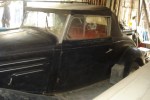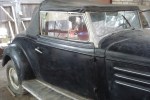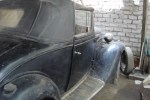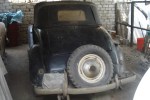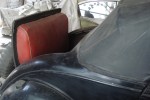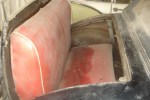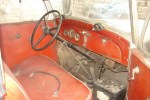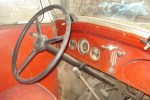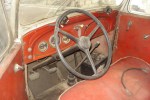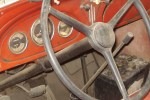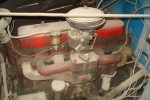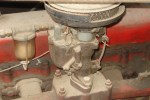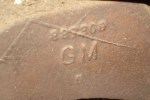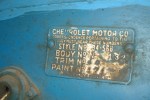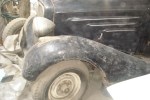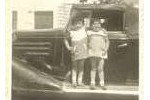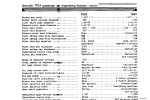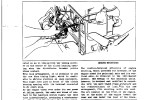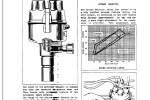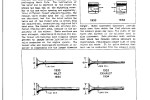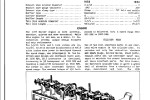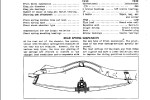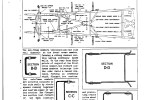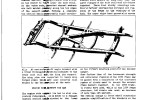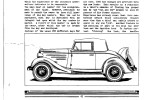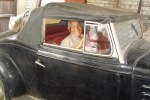Chevrolet Master Series DA Convertible
- 1934
- 0 km
- Barn Find
- Peruvian title
- Peruvian taxes paid
- Sold
Due to the owners' age, we have been asked to offer his project Ford Fairlane as well as barn-find 1934 Chevrolet Six Master Series DA Cabriolet with rumble seat for sale.
Most 1934 Chevrolet's were sedans, and most coupes were the Business model, without a rumble seat. The Master Six Convertible with rumble seat body-style No 568 was only available in 1934.
1933 Master Eagles as well as all Standard Six convertibles come with a different wheelbase.
With only 1,974 build and many converted into Hot Rods' this is an opportunity to acquire an unusually, most uncommon and highly desirable version of a very attractive automobile from the 1930s.
This Barnfind Master Six Series DA Chevrolet comes with 100 pages of detailed technical information from General Motors in order to be able to restore the car to its former glory.
The car is ready to be inspected by appointment in Lima, Peru. Taxi transfer from Jorge Chávez International Airport takes approximately 45 minutes.
The first-generation Chevrolet inline six has long lived in the shadow of the Ford flathead V-8 - so much so that many don't realize that it's a different creature from the 216-cu.in., 235-cu.in. and 261-cu.in. engines that replaced it, with all Chevy sixes from 1929 to 1962 being lumped together as "Stovebolts."
In reality, the 1929 to '36 Chevrolet inline six was even further removed from its 1937 to '62 successors than was the 1932 to '36 Ford V-8 from its 1937-'48 and '49-'53 progeny. The 1929-'36 engines are the true Stovebolts, with the '37-'62 engines being more properly labeled "Blue Flame Sixes."
The first-generation Chevrolet six-cylinder was developed as a replacement for the 1914-vintage Chevrolet four, a 171-cu.in. OHV engine that started life in the Royal Mail and Baby Grand Chevrolets and powered the Chevrolet 490 as it attempted to take on Ford directly. Ultimately, the Chevy four's biggest success would be in the 1923-'26 Superior series as it slowly eroded Ford's market share from above.
With the debut of the 1927 Capitol-series Chevrolet, it was becoming increasingly evident that the public's taste was turning away from rough-idling four cylinders and toward the smoother power of the inline six-usually in the form of a used car from the middle-price class. Chevrolet set out to develop a clean-sheet engine design that would allow the public to purchase a brand-new six-cylinder automobile in the low-price class.
The result was supposed to be ready for 1928, and if one studies the National-series Chevrolet, it is quickly evident that it was designed around a six-cylinder engine. The wheelbase was increased by four inches, to 107 inches, and the extra length was all in the engine bay.
Chevrolet was still stinging from the 1923 recall of the "Copper Cooled" Series C, which saw the company recall and destroy nearly the entire production run. As such, Chevrolet elected not to introduce the six without being absolutely certain it was ready and instead substituted the tried-and-true four with a revised head as a stopgap. The additional space in the engine bay was ameliorated by an extra-deep fan shroud between the four-cylinder engine and the radiator.
or 1929, though, the "Cast Iron Wonder" was ready. The timing was impeccable, as Ford's new Model A had stolen the show, and once the production difficulties of 1928 were sorted out, Ford recaptured first place from Chevrolet for the first time since 1926. The new "Six in the price range of the four" allowed Chevrolet to stay relevant in the face of the all-new Ford.
The 194-cu.in. Chevrolet six-cylinder featured a 3-5/16" bore and a 3-3/4" stroke. The crankshaft rode in three poured-babbitt main bearings benefiting from a low-pressure oiling system that squirted oil on the main bearings. Rod bearings, also babbitted, were oiled via the traditional "splash oiling" system using dippers on the rods themselves. The new engine, like the outgoing four, breathed through an up-draft Carter one-barrel carburetor.
With around 5:1 compression (Chevrolet didn't offer an official figure, but this is what enthusiasts have calculated), the six produced 46 horsepower at 2600 RPM. And yes, the engine featured certain external fasteners with a slotted head, similar to the bolts that held together contemporary woodstoves-leading to the "Stovebolt" moniker.
Changes to the Stovebolt were minimal for 1930, save possibly a slight bump in compression to 5.02:1. Nevertheless, the 1930 and '31 engines were rated at 50 horsepower at 2600 RPM. In 1931, Chevrolet finally recaptured first place in sales from Ford, although sales overall were way down thanks to the onset of the Great Depression.
For 1932, the six received another compression bump, to 5.2:1, and a down-draft Carter W-1 carburetor-versions of which would grace the Chevrolet six every year until 1950. The combination was enough to push the Stovebolt to 60 horsepower at 3000 RPM. From a sales perspective, Chevrolet remained in first place, but the public's head was turned away from the six thanks to Ford's new 65-horsepower V-8, which was Henry's answer to the end of the four-cylinder era.
For 1933, Chevrolet split its line into two series: the upscale "Master" and the price-leading "Standard". The Master had grown from 1932, riding a 110-inch wheelbase and featuring an enlarged six with a taller-deck cylinder block to accommodate a four-inch stroke. The new engine displaced 206.8 cubic inches and produced 65 horsepower.
At midyear, Chevrolet brought back the old 107-inch wheelbase and assembled lighter-duty components into the Standard. Into the same new engine block as the Master went a 3-1/2" stroke crankshaft to produce a 181-cu.in., 60-horsepower version of the six. Standards sold for $50 to $60 less than Masters and were lighter by over 200 pounds. Chevrolet retained its sales lead another year.
Another development showing that the day of the four cylinder was over (for now) occurred in 1933, with Plymouth abandoning its Maxwell-based L-head four for an inline six cribbed from its DeSoto stablemate. With scant revision, that engine design would continue to power Plymouth passenger cars until 1959.
Although the appearance changed little and the engine not at all, the 1934 Chevrolet Master was significantly heavier and more expensive than the 1933-likely thanks to the newly standard Dubonnet "Knee-Action" independent front suspension. Whether it was because of this or because of the ever-worsening Depression, the public's enthusiasm for Chevrolets slipped and Ford regained first place.
Perhaps attempting to make up for the lost performance of 1934, Chevrolet increased the compression of the 207 to 5.45:1 for 1935 and dropped the 181 entirely. Despite having apparently the same engine, Chevrolet rated the Standard as having 74 horsepower and the Master as having 80. This may have been a marketing decision, however, as the Standard engine was rated at 3200 RPM, whereas the Master's horsepower was measured at 3300 RPM.
Although the 1935 Chevy standard may have been something of a sleeper, it was not enough to recapture the sales lead from Ford. Perhaps realizing that it was never going to obtain a reputation to match the V-8, it was around this time that Chevrolet began to emphasize the durability and economy of the Stovebolt. For 1936, compression increased yet again, now to 6.0:1, but power was rated as 79 horsepower at 3200 RPM for both Master and Standard.
It was also around this time that Chevrolet engineers began to be quoted in the press and Chevrolet short films began to emphasize the efficiency of the Stovebolt combustion chamber design in getting every bit of power from the fuel used. The metaphor they used is familiar to anyone who has used a Bunsen burner and tuned the flame from a sooty yellow to a hot, clean blueish-white: The Blue Flame.
For 1937, to better accommodate the changes envisioned for future increases in durability and efficiency, the Chevrolet six underwent a major redesign. While the oiling system changed little, the crank was de-stroked to 3-3/4? and now rode in four main bearings. The cylinder bores were enlarged to 3-1/2? and compression was increased yet again to 6.25:1. This new 216.5-cu.in. engine produced 85 horsepower and was so successful it would form the basis for Society of Automotive Engineers engine evaluations for years to come.
The tale of the 216 and its descendants is better suited to another story, however. And the story of the original Stovebolt doesn't end here. In Japan a new company was starting production of a downsized version of the DeSoto Airflow. Rather than copy the DeSoto's flathead engine, however, it was decided to license the outgoing six-cylinder design from General Motors. Thus, a metricized 3.9-liter Stovebolt would power Toyota cars and trucks from 1936 to 1947 before it was in turn replaced by a license-built version of the Blue Flame design.
Today the early Stovebolt is a largely unremembered engine but it is not significantly inferior to its immediate competitors of the era. It does suffer from some complexity at rebuild time due to the difficulty and expense of having older engines re-babbitted, but this is equally true of the Ford engines of the 1929-'35 model years. For its time, however, the Chevy Stovebolt was a mechanical marvel. Isn't it time you gave the Cast Iron Wonder a second look?
“ your classic auto specialist; world-wide collector car expertise ”
We buy, sell, broker, locate, consign and appraise exceptional classic, sports and collector automobiles, arrange transport, customs formalities and registration.
Jaguar, Ferrari and Maserati expertise, though our collection includes a wide variety of other superior antique, vintage, prewar and race cars.
Contact us when you are serious about owning or selling a fine classic motor car or motorcycle. Geneva, Switzerland-based, we serve clients world-wide.
Chemin des Tulipiers | 1208 | Geneva | Switzerland | +41 (0) 787.055.745
